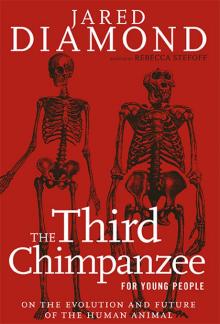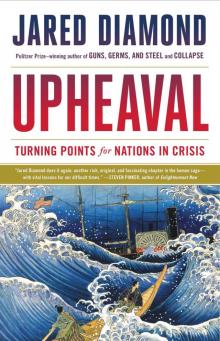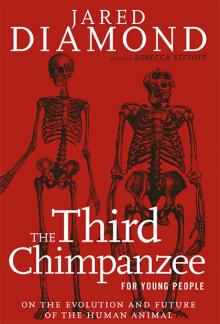- Home
- Jared Diamond
The Rise and Fall of the Third Chimpanzee Page 26
The Rise and Fall of the Third Chimpanzee Read online
Page 26
Picologists, the scientists who specialize in studying woodpeckers, take that conclusion for granted. On reflection, though, it is startling to the rest of us non-picologists who had convinced ourselves that woodpecking would evolve repeatedly. Could it be that other pseudo-woodpeckers did evolve, but that our surviving woodpeckers were so superior that they exterminated their unrelated competitors? For example, separate groups of mammalian carnivores evolved in South America, Australia, and the Old World. But the Old World carnivores (our cats and dogs and weasels) proved so superior that they exterminated South America’s carnivorous mammals millions of years ago and are now in the process of exterminating Australia’s carnivorous marsupials. Was there a similar shootout in the woodpecker niche?
Fortunately, we can test that theory. True woodpeckers do not fly far over water, with the result that they never colonized remote oceanic land masses like Australia/New Guinea (formerly joined in a single land mass), New Zealand, and Madagascar. Similarly, placental terrestrial mammals other than bats and rodents were never able to reach Australia/New Guinea, where instead marsupials evolved good functional equivalents of moles, mice, cats, wolves, and anteaters. Evidently it was not so hard to fill those mammalian niches by convergent evolution. Let’s see what happened to the woodpecker niche in Australia/New Guinea.
We find there a diverse array of birds that evolved convergently to feed on or under bark, including pygmy parrots, birds of paradise, honeyeaters, Australian creepers, Australian nuthatches, ploughbills, ifritas, and flycatchers. Some of those birds have powerful bills used to dig into dead wood. Some of them have evolved elements of the woodpecker anatomical syndrome, such as stiff tails and tough skins. The species that has come the closest to filling the woodpecker niche is not a bird at all but a mammal, the striped possum, which taps on dead wood to detect insect tunnels, rips open the wood with its incisor teeth, then inserts its long tongue or very long fourth finger to pull out the insects.
However, none of these would-be woodpeckers has actually made it into the woodpecking niche. None can excavate live wood. Many are visibly inefficient; I recall seeing a black-throated honeyeater trying to hop up a tree trunk and repeatedly falling off. The ploughbill and striped possum seem to be the would-be’s most effective at digging in dead wood, but both are quite uncommon and evidently cannot make a good living by their efforts. New Zealand’s and Madagascar’s pseudo-woodpeckers are no better. In a stunning instance of convergent evolution, Madagascar’s best would-be is also a mammal, a primate called the aye-aye, that operates like a striped possum except for having a very long third instead of a fourth finger. But just as in Australia/New Guinea, none of the would-be’s in New Zealand or Madagascar can excavate in live wood.
Thus, in the absence of woodpeckers, many try, and none succeeds. The woodpecker niche is flagrantly vacant on those masses not reached by woodpeckers. If woodpeckers had not evolved that one time in the Americas or Old World, a terrific niche would be flagrantly vacant over the whole Earth, just as it has remained vacant in Australia/New Guinea, New Zealand, and Madagascar.
*
I have dwelt on woodpeckers at length to illustrate that convergence is not universal, and that not all opportunities are seized. I could have illustrated the same point with other, equally flagrant examples. The most ubiquitous opportunity available to animals is to consume plants, much of whose mass consists of cellulose. Yet no higher animal has managed to evolve a cellulose-digesting enzyme. Those animal herbivores that digest cellulose instead have to rely on microbes housed within their intestines. Among such herbivores, none comes close to achieving the efficiency of ruminants, the cud-chewing mammals exemplified by cows. To take another example that I discussed in Chapter Ten, growing your own food would seem to offer obvious advantages for animals, but the only animals to master the trick before the dawn of human agriculture 10,000 years ago were leaf-cutter ants and their relatives plus a few other insects, which cultivate fungi or domesticate aphid ‘cows’.
Thus, it has proved extraordinarily difficult to evolve even such obviously valuable adaptations as woodpecking, digesting cellulose efficiently, or growing one’s own food. Radios do much less for one’s food needs and would seem far less likely to evolve. Are our radios a fluke, unlikely to have been duplicated on any other planet?
Consider what biology might have taught us about the inevitability of radio evolution on Earth. If radio-building were like woodpecking, some species might have evolved certain elements of the package or evolved them in inefficient form, although only one species managed to evolve the complete package. For instance, we might have found today that turkeys build radio transmitters but no receivers, while kangaroos build receivers but no transmitters. The fossil record might have shown dozens of now-extinct animals experimenting over the last half-billion years with metallurgy and increasingly complex electronic circuits, leading to electric toasters in the Triassic, battery-operated rat traps in the Oligocene, and finally radios in the Holocene. Fossils might have revealed 5-watt transmitters built by trilobites, 200-watt transmitters amidst bones of the last dinosaurs, and 500-watt transmitters in use by sabertooths, until humans finally upped the power output enough to be the first to broadcast into space.
But none of that happened. Neither fossils nor living animals – not even our closest living relatives, the common and pygmy chimpanzees – had even the most remote precursors of radios. It is instructive to consider the experience of the human line itself. Neither australopithecines nor early Homo sapiens developed radios. As recently as 150 years ago, modern Homo sapiens did not even have the concepts that would lead to radios. The first practical experiments did not begin until around 1888; it is still less than 100 years since Marconi built the first transmitter capable of broadcasting one mere mile; and we still are not sending signals targeted at other stars, though the 1974 Arecibo experiment was our first attempt.
I mentioned early in this chapter that the existence of radios on the one planet known to us seemed at first to suggest a high probability of radios evolving on other planets. In fact, closer scrutiny of Earth’s history supports exactly the opposite conclusion: radios had a vanishingly low probability of evolving here. Only one of the billions of species that have existed on Earth showed any proclivities towards radios, and even it failed to do so for the first 69,999/70,000ths of its seven-million-year history. A visitor from outer space who had come to Earth as recently as the year 1800 AD would have written off any prospects of radios being built here.
You might object that I am being too stringent in looking for early precursors of radios themselves, when I should instead look just for the two qualities necessary to make radios, intelligence and mechanical dexterity. The situation there is little more encouraging. Based on the very recent evolutionary experience of our own species, we arrogantly assume intelligence and dexterity to be the best way of taking over the world, and to have evolved inevitably. Think again about that quote from the Encyclopaedia Britannica: ‘It is difficult to imagine life evolving on another planet without progressing towards intelligence.’ Earth history again supports exactly the opposite conclusion. In reality, vanishingly few animals on Earth have bothered with much of either intelligence or dexterity. No animal has acquired remotely as much of either as have we; those that have acquired a little of one (smart dolphins, dexterous spiders) have acquired none of the other; and the only other species to acquire a little of both (common and pygmy chimpanzees) have been rather unsuccessful. Earth’s really successful species have instead been dumb and clumsy rats and beetles, who found better routes to their current dominance.
*
We have only still to consider the last missing variable in the Green Bank formula for calculating the likely number of civilizations capable of interstellar radio communication. That variable is the lifetime of such a civilization. The intelligence and dexterity required to build radios are useful for other purposes that have been our species’ hallmark for much longe
r than have radios and that will be the subject of the remaining chapters in this book: purposes such as mass-killing devices and means of environmental destruction. We have become so potent at doing both that we are gradually stewing in our civilization’s juices. We may not enjoy the luxury of an end by slow stewing. Half-a-dozen countries now possess the means for bringing us all to a quick end, and still other countries are eagerly seeking to acquire those means. The wisdom of some past leaders of bomb-possessing nations, or of some present leaders of bomb-seeking nations, does not encourage us to believe that there will be radios on Earth for much longer.
It was an extremely unlikely fluke that we developed radios at all, and more of a fluke that we developed them before we developed the technology that will end us in a slow stew or fast bang. While Earth’s history thus offers little hope that radio civilizations exist elsewhere, it also suggests that any that might exist are short-lived.
We are very lucky that that is so. I find it mind-boggling that the astronomers now eager to spend a hundred million dollars on the search for extraterrestrial life have never thought seriously about the most obvious question: what would happen if we found it, or if it found us. The astronomers tacitly assume that we and the little green monsters would welcome each other and settle down to fascinating conversations. Here again, our own experience on Earth offers useful guidance. We have already discovered two species that are very intelligent but technically less advanced than us – the common chimpanzee and pygmy chimpanzee. Has our response been to sit down and try to communicate with them? Of course not. Instead we shoot them, stuff them, dissect them, cut off their hands for trophies, put them on exhibit in cages, inject them with AIDS virus as a medical experiment, and destroy or take over their habitat. That response was predictable, because human explorers who discovered technically less advanced humans also regularly responded by shooting them, decimating their populations with new diseases, and destroying or taking over their habitat.
Any advanced extraterrestrials who discovered us would surely treat us in the same way. Think again of those astronomers who beamed radio signals into space from Arecibo, describing Earth’s location and its inhabitants. In its suicidal folly that act rivalled the folly of the last Inca emperor, Atahuallpa, who described to his gold-crazy Spanish captors the wealth of his capital and provided them with guides for the journey. If there really are any radio civilizations within listening distance of us, then for heaven’s sake let’s turn off our own transmitters and try to escape detection, or we are doomed.
Fortunately for us, the silence from outer space is deafening. Yes, out there are billions of galaxies with billions of stars. Out there must be some transmitters as well, but not many, and they do not last long. Probably there are no others in our galaxy, and surely none within hundreds of light-years of us. What woodpeckers teach us about flying saucers is that we are unlikely ever to see one. For practical purposes, we are unique and alone in a crowded universe. Thank God!
PART FOUR
WORLD CONQUERORS
PART THREE DISCUSSED some of our cultural hallmarks and their animal precedents or precursors. Several of those hallmarks are ones that we are proud of, though one (agriculture) has proved to be a mixed blessing and another (chemical abuse) an unmitigated evil. Those cultural hallmarks – especially language, agriculture, and advanced technology – have been the causes of our rise. They are what permitted us to expand over the globe and become world conquerors.
That expansion, though, consisted of more than our conquering areas previously unoccupied by the human species. It also involved the expansion of particular human populations that conquered, expelled, or killed other populations. We became conquerors of each other, as well as of the world. Thus, our expansion has been marked by yet another human hallmark that has animal precursors and that we have taken far beyond its animal limits – namely, our propensity to kill other members of our species en masse. Along with our environmental destructiveness, it now poses one of the two potential causes for our fall.
To appreciate our rise to the status of world conquerors, recall that most animal species are distributed over only a small part of the Earth’s surface. For example, Hamilton’s frog is confined to one forest patch of thirty-seven acres plus one rock-pile covering 720 square yards in New Zealand. The most widespread wild land mammal other than humans used to be the lion, which as of 10,000 years ago occupied most of Africa, much of Eurasia, North America and northern South America. Even at the time of its greatest extent, though, the lion did not reach Southeast Asia, Australia, southern South America, the polar regions, or islands. There are even more widespread bird species that occur on all continents except Antarctica, such as the barn owl or peregrine falcon, but they too are absent from many islands, high elevations, cold climates, and all the oceans.
Humans used to have a typically mammalian restricted distribution, in warm, non-forested areas of Africa. As recently as 50,000 years ago, we were still confined to tropical and mild-temperature areas of Africa and Eurasia. Then we expanded in turn to Australia and New Guinea (around 50,000 years ago), cold parts of Europe (by 30,000 years ago), Siberia (by 20,000 years ago), North and South America (around 11,000 years ago), and Polynesia (between 3,600 and 1,000 years ago). One dramatic stage in this expansion of ours into a large realm formerly without people – the New World – will be the subject of a later chapter, Chapter Eighteen. Today we occupy or at least visit not only all lands but also the surface of all the oceans, and we are starting to probe into space and the oceans’ abysses.
In the process of this world conquest, our species underwent a basic change in the relations between its populations. Most animal species with sufficiently wide geographic ranges fall into populations that have contact with neighbouring populations but have little or no contact with distant ones. In this respect, too, humans used to be just another species of big mammal. Until relatively recently, most people spent their entire lives within a few dozen miles of their birthplace, and had no way of learning even of the existence of people living at much greater distances. Relations between neighbouring tribes were marked by an uneasy shifting balance between trade and xenophobic hostility.
This fragmentation promoted, and was reinforced by, the tendency for each human population to develop its own language and culture. Initially, the massive expansion of our species’ geographic range involved a massive increase in our linguistic and cultural diversity. Among the ‘new’ parts of our range occupied only within the last 50,000 years, New Guinea and North and South America alone came to account for about half of the modern world’s languages. Much of that long heritage of cultural diversity has been erased in the last 5,000 years by the expansion of centralized political states. Freedom of travel – a modern invention – is now accelerating that homogenization of our language and culture. However, in a few areas of the world, notably New Guinea, stone-age technology and our traditional xenophobic outlook persisted into the Twentieth Century, giving us a last glimpse of what the rest of the world used to be like. Chapter Thirteen will try to convey some feeling for our pre-homogenized condition, and for what we have lost as well as gained through our new-found mobility.
The outcome of conflicts between expanding human groups has been heavily influenced by group differences in our cultural hallmarks. Especially decisive have been differences in military and maritime technology, in political organization, and in agriculture. Groups with more advanced agriculture thereby acquired the military advantage of larger population numbers, ability to support a permanent military caste, and resistance to infectious diseases against which sparser populations had evolved no defence.
All those cultural differences used to be ascribed to genetic superiority of conquering ‘advanced’ peoples over conquered ‘primitive’ ones. However, no evidence of such genetic superiority has been forthcoming. The likelihood of genetics playing such a role is refuted by the ease with which the most dissimilar human groups have mastered each other
’s cultural techniques, given adequate learning opportunities. New Guineans born of stone-age parents now pilot aeroplanes, while Amundsen and his Norwegian crew mastered Eskimo dog-sledding methods to reach the South Pole.
Instead, one has to ask why some people acquired the cultural advantages that let them conquer other people, despite lack of any evident genetic advantages. For example, was it purely by chance that Bantu peoples originating from equatorial Africa displaced Khoisan people over most of southern Africa, rather than vice versa? While we cannot expect to identify ultimate environmental factors behind small-scale conquests, chance should play less of a role and ultimate factors should be more compelling if we focus on large-scale population shifts over long times. Hence Chapters Fourteen and Fifteen will examine two of the largest-scale shifts in recent history: the modern expansion of Europeans over the New World and Australia; and the perennial puzzle of how Indo-European languages managed earlier to overrun so much of Eurasia from an initially restricted homeland. We shall see clearly in the former case, and more speculatively in the latter, how each human society’s culture and competitive position have been shaped by its biological and geographical heritage, especially by the plant and animal species available to it for domestication.
Competition among members of the same species is not unique to humans. Among all animal species as well, the closest competitors are inevitably members of the same species, because they share the closest ecological similarity. What varies greatly among species is the form that competitive strife takes. In the most inconspicuous form, rival animals compete merely by consuming food potentially available to each other and exhibit no overt aggression. Mild escalation involves ritualized displays, or chasing. As a last resort, now documented in many species, rival animals kill each other.

 Why Is Sex Fun?: The Evolution of Human Sexuality
Why Is Sex Fun?: The Evolution of Human Sexuality Guns, Germs, and Steel: The Fates of Human Societies
Guns, Germs, and Steel: The Fates of Human Societies Collapse: How Societies Choose to Fail or Succeed
Collapse: How Societies Choose to Fail or Succeed The Third Chimpanzee: The Evolution and Future of the Human Animal
The Third Chimpanzee: The Evolution and Future of the Human Animal The World Until Yesterday: What Can We Learn From Traditional Societies?
The World Until Yesterday: What Can We Learn From Traditional Societies? The Rise and Fall of the Third Chimpanzee
The Rise and Fall of the Third Chimpanzee Upheaval: Turning Points for Nations in Crisis
Upheaval: Turning Points for Nations in Crisis Guns, Germs, and Steel
Guns, Germs, and Steel The Third Chimpanzee for Young People
The Third Chimpanzee for Young People Why Is Sex Fun?
Why Is Sex Fun?